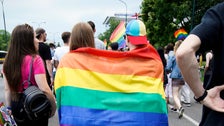
NEW YORK, July 15 (Reuters) – Forty percent of young LGBTQ people in the United States say they have seriously considered suicide over the past 12 months, according to a survey released on Wednesday, while the figure climbs to more than 50% for transgender and non-binary youth surveyed.
Although data on LGBTQ experiences is limited, studies have found that lesbian, gay, bisexual, transgender and queer youth are more likely to attempt suicide than their peers.
Among all people aged 10 to 24, suicide is the second-leading cause of death, according to the Trevor Project, a non-profit focused on suicide prevention among youth who identify as lesbian, gay, bisexual, transgender and queer including non-binary people, individuals whose gender identity or expression falls outside the categories of male and female.
The survey was conducted between Dec. 2, 2019 and March 31, 2020 – mostly before the coronavirus outbreak began to sweep through the United States. It builds on the project’s first national survey released last year that found 39% of LGBTQ youth had seriously considered attempting suicide in the past 12months.
The pandemic is likely to have made matters worse for some young LGBTQ people, one of the communities that experts say could be affected at disproportionate rates by the coronavirus.
“We’ve seen increased volume on our direct crisis services and at times that was more than double our typical volume,” Amit Paley, CEO and executive director of The Trevor Project, told Reuters. “There’s so many young people who are just cut off from their normal sources of support so they don’t have people or friends or resources they can turn to.”
The survey, the largest of its kind, also showed that manyLGBTQ youth lack the opportunity and means to access the mental healthcare they say they need.
Nearly half (46%) of the 40,000 respondents said they wanted psychological or emotional counseling from a professional but were unable to receive it over the course of the past 12 months.
In a time of pandemic, access to potentially life-saving care, including mental healthcare, has become more challenging for both patients and providers, exacerbating issues like isolation, access to hormone treatments and gender-related surgeries for many in the LGBTQ community.
Telemedicine has proved very effective in providing services to many LGBTQ people during the pandemic, said Maureen Kelly ofPlanned Parenthood of Greater New York. But it also highlighted historic barriers facing LGBTQ people and youth like finding a provider that is competent to treat LGBTQ patients or reliable internet services.
“We know that some, particularly Black and brown patients, are struggling much more in different ways with underpowered internet services,” Kelly said.
For young queer individuals, being forced to isolate with unsupportive families might pose a further obstacle. Forty percent of LGBTQ youth reported in the survey that they were unable to receive care due to concerns over parental support.
“Part of COVID-19 impacts families,” said Paley. “Families who might not be accepting when they’re facing stress because of losing their job or being out of work or fearing being out of work, they can often take out that anger or stress on LGBTQ youth in their life.”
Devon Ritz, who helps run a Planned Parenthood support group for LGBTQ youth in upstate New York, said that when the pandemic forced their weekly meetings to go online, there was a lot of concern about isolation and young people in rural areas not getting the social support they needed.
“The main reason our youth group started over a decade now ago was to reduce social isolation,” Ritz said. “So it’s definitely been exacerbated by COVID-19.”
(Reporting by Maria Caspani, Editing by Tom Brown)
Calling all HuffPost superfans!
Sign up for membership to become a founding member and help shape HuffPost’s next chapter
Credit: Source link